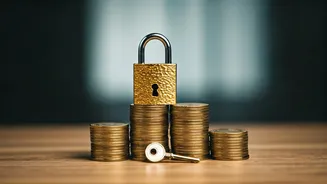EPF: The Basics
The Employees' Provident Fund (EPF) is a retirement savings scheme designed to provide financial security for employees after they retire. It is a mandatory
contribution scheme for most salaried employees in India. Both the employer and employee contribute a certain percentage of the employee's salary towards the EPF account. These contributions, along with the interest earned, accumulate over time, building a substantial corpus for retirement. While the primary goal of the EPF is to provide a retirement corpus, the government has provided certain provisions for early withdrawals, under specific circumstances, as detailed later.
When Can You Withdraw?
Contrary to the belief that the EPF is locked until retirement, there are various situations where employees can withdraw funds before reaching retirement age. The Ministry of Labour and Employment has established specific conditions that permit partial or full withdrawals. Some of the most common reasons for early withdrawals include medical emergencies, such as serious illnesses affecting the employee or a family member. Employees can also withdraw funds for specific purposes like higher education of children or for the marriage of children. Additionally, EPF withdrawals are allowed for the purchase or construction of a house, or for repayment of a housing loan. It's crucial to understand the eligibility criteria and documentation needed for each of these circumstances.
Medical Emergencies
One of the key situations permitting early EPF withdrawals revolves around medical emergencies. If an employee, their spouse, children, or parents require medical treatment for a serious illness, they can apply to withdraw funds from their EPF account. The amount that can be withdrawn is often determined by the actual cost of treatment, with certain limits specified. The employee needs to submit relevant medical documentation, such as medical certificates and hospital bills, to support their claim. This provision helps alleviate financial burdens during difficult health crises. Detailed information regarding the definition of 'serious illness', along with the required paperwork, can be obtained from the EPFO website or the employer's HR department.
Education and Marriage
Financial support for education and marriage are also valid reasons for withdrawing from your EPF account before retirement. Employees can withdraw funds to cover expenses associated with their children's higher education, such as tuition fees, and other related costs. Similarly, withdrawals are allowed for the marriage of an employee's children, helping with wedding expenses. The amount eligible for withdrawal and the conditions of applying will depend on current EPFO guidelines. Employees will need to provide necessary documents like proof of admission or marriage certificates along with their application. These provisions recognize the important life events and provide some financial assistance.
Housing Purposes
EPF funds can be utilized to facilitate home ownership. Employees can withdraw funds for the purchase or construction of a house, or even for the repayment of an existing housing loan. The EPFO has specific rules on the eligibility, the amount that can be withdrawn, and the number of years of service required. The amount usually depends on the cost of the property, or the outstanding loan amount. Employees are required to provide relevant documentation, such as property-related documents and loan statements, while applying. These housing-related provisions assist employees in achieving their real estate goals.
Withdrawal Rules Overview
The regulations concerning EPF withdrawals involve a range of factors like the amount that can be withdrawn, and the eligibility criteria tied to specific purposes. In most cases, the amount available for withdrawal is based on a percentage of the employee's EPF balance. The EPFO typically revises these rules periodically, so it's essential to stay updated. Employees should carefully review the specific guidelines and any changes announced by the EPFO before making any withdrawal requests. Additionally, there may be waiting periods, and different rules will apply based on the purpose of the withdrawal. Thoroughly reviewing the rules is critical to a smooth and successful withdrawal process. It is advisable to consult EPFO guidelines or your employer for any specific query.
Documentation Essentials
To apply for an EPF withdrawal, you will need to prepare the required documents. These usually include a completed application form, the employee's KYC details (like PAN card, Aadhaar card, and bank account details), along with proof supporting the reason for the withdrawal. For instance, medical bills are necessary for medical emergencies, and educational institution documents are needed for educational purposes. For housing purposes, the required paperwork involves property-related documents, and the loan statements. Accuracy and completeness in documentation are crucial for the efficient processing of your claim. It's advised to verify the latest required documents from the EPFO website or your employer to ensure no delays.
Tax Implications
Understanding the tax implications of EPF withdrawals is important. Generally, withdrawals are tax-exempt if you have completed five years of continuous service. If you withdraw before five years, the withdrawn amount is taxable, and tax will be deducted at source (TDS). The tax rate depends on the applicable income tax slabs. In certain cases, like withdrawals due to medical emergencies or other unforeseen circumstances, there might be exceptions to this rule. It is advisable to consult a tax advisor to understand the tax implications of withdrawing EPF funds based on your specific situation. This ensures that you are aware of the tax liabilities before processing the withdrawal.
Online Application Process
The Employees’ Provident Fund Organisation (EPFO) provides a user-friendly online portal for EPF-related services, including withdrawal requests. Employees can submit withdrawal applications online by visiting the EPFO portal. You will usually need to log in to the portal using your UAN (Universal Account Number) and password. Before starting the online process, ensure your KYC details are updated and verified. The online process requires you to fill in the application form, upload supporting documents, and submit it. After submission, you can track the progress of your application online. The online method has simplified the process, making it more convenient for employees to manage their EPF.
Important Considerations
When considering an EPF withdrawal, there are several key points to take into account. Remember that withdrawing funds before retirement can reduce the corpus available for your retirement. This could impact your financial security during your retirement years. Assess your current financial needs versus your future financial goals before making the decision. Explore any alternatives, such as loans or other financial options, if possible. Consider the tax implications and understand how the withdrawal could impact your tax liability. It is important to stay updated with the most current EPFO rules and regulations. If in doubt, seeking professional financial advice can help make an informed decision aligned with your financial objectives.











